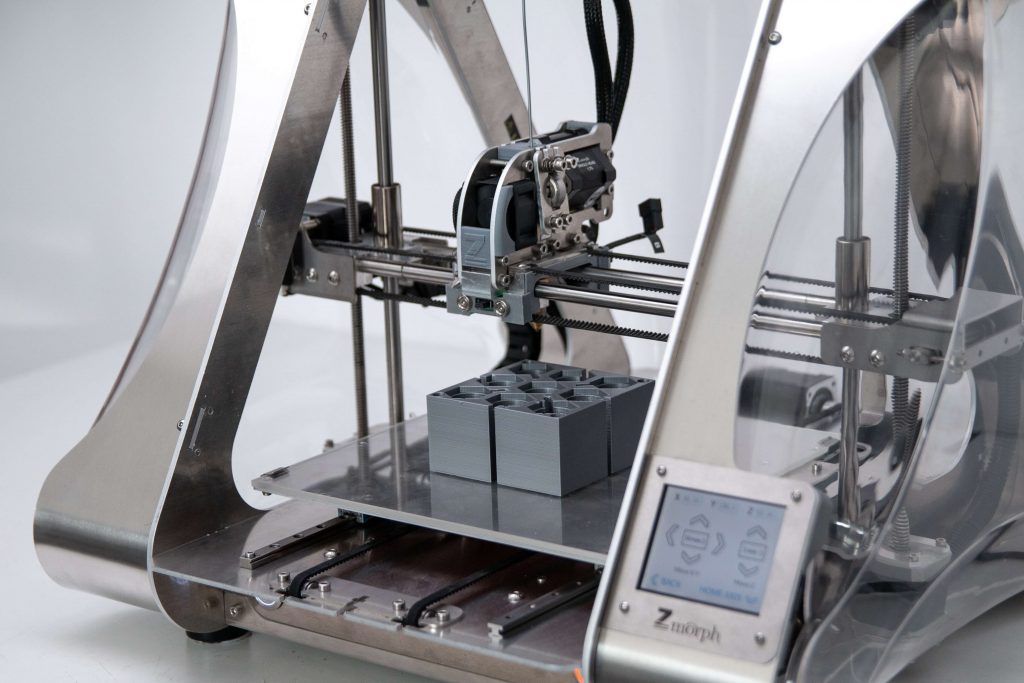
Photo by @zmorph3d on Unsplash
As the world enters the Fourth Industrial Revolution, or Industry 4.0, buzzwords such as additive manufacturing and 3D printing are disrupting the manufacturing industry and transforming the roles of manufacturers, designers and producers. While the technology has been around since the 1980s, it is beginning to grow in popularity in recent years as computing power increases, more data becomes available, and technology becomes more integrated into our workflows. Today, the 3D printing market is projected to grow at a compound annual rate of 30.2% to reach a total market size of $22 billion by 2022, up from just $6 billion in 2017.
What is Additive Manufacturing
Additive manufacturing and 3D printing are synonyms. As implied from its name, additive manufacturing adds material to create a three-dimensional object. Using data from a digital sketch using computer-aided-design (CAD) software, material is deposited layer upon layer in precise patterns in order to produce the final 3D-printed object. This is in direct contrast to traditional approaches to manufacturing, whereby portions of materials are removed through subtractive techniques such as carving, shaping or sculpting.
Adoption of Additive Manufacturing in the Fashion Industry
The fashion industry is also awakening to the benefits and improvements that 3D Printing might bring to the design and manufacturing process. Dutch haute couturier Iris van Herpen is arguably the pioneer of 3D printing in fashion, when she presented her Escapism collection for Spring/Summer 2011 season in Paris Haute Couture Week. The entire collection, which consisted of flowing dresses and bulbous wing-shaped silhouettes, was 3D printed, and one of her dresses was even featured in TIME Magazine’s 50 Best Inventions for that year. This revolutionary technique inspired independent designers such as ecologist and clean technology industry manager Julia Daviy and footwear designer Silvia Fado, who use additive manufacturing to design 3D printed dresses, tops and shoes.
Today, the users of additive manufacturing have broadened beyond haute couture ateliers into startups and commercial manufacturers alike, such as Boston-based high performance businesswear label Ministry of Supply, German conglomerate Adidas, and even luxury watchmakers like Officine Panerai. Additive manufacturing technologies are implemented into the design processes of all kinds of garments, ranging from clothes, accessories, jewelries and even shoes.
Such a widespread adoption of additive manufacturing is in large part due to the potential benefits that this technology brings to the design process. We explore five benefits of additive manufacturing in further detail.
Optimisation of Design and Prototyping Processes
With CAD software, designers do not need to spend as much time physically drawing and editing illustrations of their prototypes during their ideation stages of their creative process. They also do not need to assemble physical prototypes by hand in order to visualise their designs. As a result, their creative process becomes more efficient and designers can spend more time on iterative prototyping and experimentation with a wider range of prototypes, instead of devoting time and effort on their individual construction.
Enhanced Accuracy and Accountability in Other Stages of the Supply Chain
Beyond the creative process, designers can also use additive manufacturing technologies to provide more accurate samples and renders when marketing their designs to potential buyers. By being able to visualise designers’ products more accurately, buyers might be more incentivised to make a sale. In addition, other players in the supply chain such as vendors are also held to higher, more transparent standards. For instance, according to FashionRetail blog, when sourcing, vendors face increased accountability to deliver accurate samples and final production. These measures heighten transparency, which translates to increased sales volumes.
Reduction in Waste
Additive manufacturing runs in direct contrast to traditional means of manufacturing, which typically involve the removal of portions of material from a source and generating inordinate volumes of waste. For instance, according to EDGE Fashion Intelligence, around 15% of clothing fabric end up as discarded textile cut-offs on the cutting room floor of factories. However, since additive manufacturing adds material to a source, these practices result in zero wastage throughout the manufacturing process. This is a more sustainable and environmentally-friendly practice that allows brands and manufacturers to meet and even exceed corporate social responsibility and sustainability objectives, providing opportunities to market their products as sustainable and environmentally-friendly.
Mass Customisation Opportunities
Developing prototypes with digital software presents endless mass customisation opportunities at a low cost. Also, such software facilitates the creation of complex shapes during the prototyping stage. Unlike traditional means of production whereby economies of scale and low costs can only be achieved when supplies are procured in bulk, additive manufacturing presents the opportunity to personalise designs at the time of production, thereby saving production time and costs. With personalisation being one of the key trends shaping consumer retail in the twenty-first century, mass customisation brings the opportunities for brands to experience increased sales and widened profit margins.
Reduction in Overall Production Costs and Increase in Profit Margin
Finally, all the benefits outlined above translate to increased profits for businesses. The additive nature of 3D printing results in zero resource wastage, and more importantly, zero sunk costs in terms of wasted resources. Optimised design and production processes across various players in the supply chain reduce the time needed to bring products to market. Coupled with sustainable marketing campaigns and mass customisation opportunities, all these advantages lead to an increased possibility in potential sales. Additive manufacturing leads to reduced operating costs and increased revenue, therefore expanding overall profit margins for businesses.
Limitations of 3D printing
While there are many advantages of 3D printing, with rapid advancements to the technology only strengthening adoption tailwinds, the current stage of 3D printing technologies brings about specific, albeit few, limitations. For instance, mainly inflexible materials can be 3D printed for now at a commercial level. Most 3D printed garments in the industry today are mesh systems that are printed individually then assembled separately. In addition, it is extremely expensive to 3D print complete garments for now. For example, a 3D printed jacket by Israeli designer Danit Peleg is listed on her website for $1,500. Therefore, full 3D printed garments are usually reserved for runway shows, such as the ones presented by Iris Van Herpen.
Nonetheless, additive manufacturing is only set to continue disrupting the fashion and manufacturing industries in the future. Brands and companies need to recognise the impact of this technology, and the potential benefits it will bring.

About the Author
Thaddeus Asher Han
Fashion Commentator & Creator
Fashion Journalist at Fashive
https://medium.com/@thaddeusasherhan